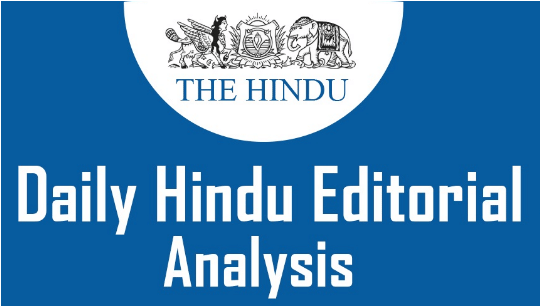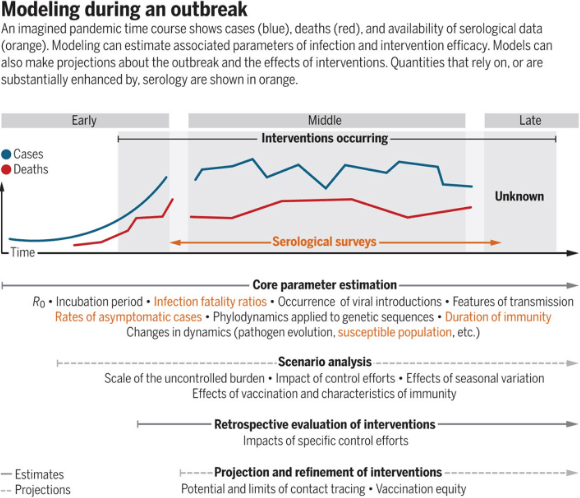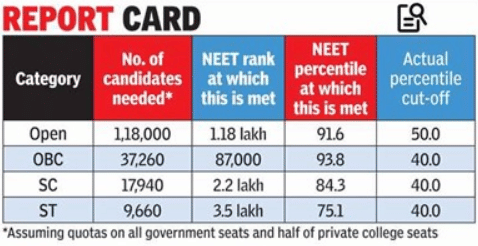The Hindu Editorial Analysis- 20th October, 2020 | Additional Study Material for UPSC PDF Download

1. A TOOL FOR THOUGHT: ON CORONAVIRUS PANDEMIC IN INDIA-
GS 2- Issues relating to development and management of Social Sector/Services relating to Health
Context
A committee of experts — well-regarded mathematicians and infectious disease experts — appointed by the Dept. of S&T to use mathematical modelling and forecast the course of the pandemic has brought good tidings.

Mathematical Modelling
(i) By their estimate, India passed its COVID-19 peak in September and the decline in the overall caseload being observed for nearly a month now is to continue.
(ii) Active cases, about 7.5 lakh now, are expected to drop below 50,000 by December, and by February, the pandemic is likely to extinguish itself with only ‘minimal’ (not zero) infections.
(iii) While it is reasonable to assume that the seven-member committee has been scrupulous(careful), the caveat(warning) is that this is still a forecast based on mathematical modelling.
(iv) There are some strong assumptions.
(v) The decline will continue only if there are no major mutations(changes) during winter, protective antibodies are durable, and current restrictions are maintained.
(vi) There would be no significant gains from a strict lockdown beyond the district level.
(vii) And current containment measures would suffice(be sufficient), except if there are local outbreaks that threaten to overwhelm health-care facilities there.
(viii) Their calculation also showed a peak by July latest, with anything from six to 15 times the existing infections had there been no lockdown or if it had been delayed to April.
Policy Changes
(i) The purpose of pandemic modelling is to generate a probabilistic overview of the future.
(ii) Mathematical modelling has become a popular, creative exercise, with several models and forecasts being made available on pre-print servers and pending peer-review.
(iii) The latest model is expected to be published in the Indian Journal of Medical Research this week, but it appears to be a quotidian(everyday) exercise.
(iv) The datasets it has relied on are publicly available and the modelling employs a category of models called SEIR that estimates, within a population, those Susceptible, Exposed, Infected and Recovered.
(v) It is extremely dependent on the quality of data that is used as an input and relies as much on simplifying assumptions that sacrifice complexity for comprehension.
(vi) But there is nothing to suggest, from what is known about the exercise, that it is more likely to be true than similar estimates from scores of models the world over that subscribe to a certain degree of rigour(rigidity).
(vii) Experts associated with the pandemic have reiterated(repeated) many times that mathematical modelling ought not to be taken literally.
(viii) The latest assessment too should then be used not to critique or justify past decisions but dwell more on the future.
(ix) For instance, if the model suggests that the pandemic would extinguish by February with a dramatic dip by December, then should the accelerated clinical trials of potential vaccines be top priority?
Conclusion
(i) Mathematical models, to be useful, must induce policy or behavioural change to avoid their own worst-case scenarios and this latest assessment must be seen — no more, no less — as a tool to this end.
(ii) Pandemic forecasts must be used to induce(add) changes and avoid worst-case scenarios.
2. THE NEET CHALLENGE: ON CONDUCTING OF NEET EXAMS-
GS 2- Issues relating to development and management of Social Sector/Services relating to Education
Context
(i) The conduct of two rounds of NEET, attendance at the test and the publication of results, all in the face of resistance from certain States, can presumably count as achievements.
(ii) The results were declared last week, and the top score was a perfect 720, scored not by one, but two students, who will have their choice of college in the undergraduate medical programme.

Standardising Medical Education
(i) The decision to conduct the exam, when there was uncertainty about the ability of students to reach the centres, was probably bold, though it had not factored in the lowest common denominator.
(ii) But then, the NEET is not about catering to the lowest common denominator.
(iii) It is avowedly(asserting) about standardising medical education, ensuring the quality of medical graduates who will hopefully go on to serve society.
(iv) Working with the ideal of raising the quality is clearly a laborious, time-consuming process, and is bound to be uneven at the start, even if all States have begun to level the playing field.
(v) Different States have been allowed to offer their own education systems — different streams with varying standards and pedagogies — and NEET brings in an overarching single syllabus not all have access to.
(vi) Therein begin the inequities.
(vii) Students in certain circumstances, (poor, living in remote areas and disadvantaged, for instance), and in certain boards of education (State board, for instance) will remain at a disadvantage, as a result of this.
Easing Access
(i) The scores show an overall improvement over the years.
(ii) States must not rest in their endeavour(journey) to ease the access to, and enhance students’ ability to clear the test successfully, even without the need to spend much on coaching classes.
(iii) Certain measures, including TN’s move to reserve 7.5% of MBBS seats for State government school students who clear NEET, running State-sponsored, free or heavily subsidised coaching programmes, and a reassessment of the regional State syllabus, will all enable a more equitable scenario.
(iv) If coaching can help bridge the yawning(widening) gap, then the State could mandate that private coaching centres do not charge exorbitantly(excess) for conducting year-long coaching programmes.
(v) They should provide reasonable subsidies for certain groups of students.
(vi) Meanwhile, the overemphasis by parents on medicine as the only career option for their wards, and wanton(deliberate) politicisation of NEET will merely serve to exacerbate(worsen) the acute deficiencies of the process.
(vii) Pandemic-related challenges not with standing, for true positive impact, any welfare state must build systems around the core ideas of equity of access and affordability — especially in education and health care.
Conclusion
As NEET progresses, States must take affirmative action to protect weaker sections.
3. MANY GAINS IN FIGHTING HIV-
GS 2- Issues relating to development and management of Social Sector/Services relating to Health
Context
(i) There is a reduction in new HIV infections among children and in AIDS-related deaths in India
(ii) In this challenging moment when we are confronted with one of the biggest health emergencies in our history, the COVID-19 pandemic, we find our strength in the gains we are making despite this disruption.

Steps Forward
(i) National AIDS Control Organization (NACO)/Ministry of Health and Family Welfare with the technical support of UNAIDS released newly 2019 HIV estimates.
(ii) It tells us that there has been a 66.1% reduction in new HIV infections among children and a 65.3% reduction in AIDS-related deaths in India over a nine-year period.
(iii) The number of pregnant women living with HIV has reduced from 31,000 in 2010 to 20,000 in 2019.
(iv) Overall, antenatal(before birth) coverage has expanded, and HIV testing has increased over time and within target range. Treatment coverage has also expanded.
(v) Under the leadership of NACO, a ‘Fast-Tracking of EMTCT (elimination of mother-to-child transmission) strategy-cum-action plan’ was outlined by June 2019.
(vi) The plan entailed mobilisation and reinforcement of all national, State and partners’ collective efforts — in a strategic manner, with district-level focus, and considering latest evidence — so that the States/Union Territories and the country as a whole achieve the EMTCT goal.
(vii) Additionally, in March 2020, we began efforts to minimise challenges posed by the COVID-19 pandemic.
Reducing The Impact
(i) From 2010 to 2019, India made important progress in reducing the HIV impact on children through prevention of mother-to-child transmission of HIV.
(ii) This was done through education and communication programmes.
(iii) It increased access to HIV services with innovative delivery mechanisms for HIV testing (community-based testing, partner testing or index testing); counselling and care; and treatment and follow-ups.
(iv) India made HIV testing for all pregnant women free and HIV treatment is offered the same way nationwide without cost to pregnant mothers living with HIV through the national ‘treat all’ policy.
(v) UNICEF is cognisant(aware) of the challenge of diagnosing 20,000 pregnant women living with HIV in an estimated 30 million pregnancies annually in India.
(vi) Now, for two years, UNICEF has worked with the World Health Organization and NACO to identify high burden districts (in terms of density of pregnant women living with HIV) as the last mile towards disease elimination(end).
(vii) Since 2002, the EMTCT of HIV programmes or prevention of parent-to-child transmission of HIV are launched in India.
(viii) A series of policy, programmatic and implementation strategies were rolled out so that all pregnant women can access free HIV testing along with other services at antenatal clinics, and free treatment regimens for life to prevent HIV transmission from mothers to babies.
(ix) This has been made possible in government health centres and grass-root level workers through village health and nutrition days and other grass-roots events under the National Health Mission.
(x) Indeed, the approach being promoted by UNICEF in focusing attention and resources in high burden districts is supported by the HIV strategic information division of NACO and UNAIDS.
(xi) This is to better understand the locations and populations most HIV affected, so that technical support and HIV services can be directed towards these areas.
Still A Long Way To Go
(i) However, there remains a need for increased treatment saturation coverage and for early HIV testing and treatment initiation to become the normal.
(ii) Periodic monitoring of the data and reviews are the mainstay of the programme response.
(iii) By 2019 it was very evident to all the stakeholders that while there are successes, we have a long way to go towards the final targets.
(ix) Using data-driven and decision-making approaches, we are certain that AIDS will no longer be a public health threat for children in India by the end 2030, if not before.
|
21 videos|562 docs|160 tests
|
FAQs on The Hindu Editorial Analysis- 20th October, 2020 - Additional Study Material for UPSC
| 1. What is the significance of the Hindu Editorial Analysis for UPSC exam preparation? |  |
| 2. How can the Hindu Editorial Analysis be utilized effectively for UPSC exam preparation? |  |
| 3. How can the Hindu Editorial Analysis help in improving language skills for the UPSC exam? |  |
| 4. Can the Hindu Editorial Analysis be beneficial for subjects other than current affairs in the UPSC exam? |  |
| 5. How can one access the Hindu Editorial Analysis for UPSC exam preparation? |  |
















